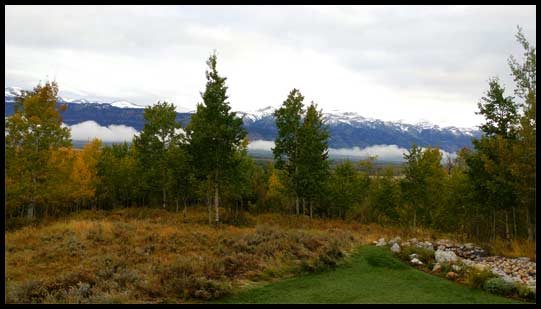Private Land in the West: A Diamond in the Rough
By: Amos S. Eno
Posted on:10/10/2017Here's a copy of a speech I gave two weeks ago in Jackson Hole, WY. Thank you to David and Maureen Brown for hosting us, and to Bob and Colleen Grady, and Rob Wallace for your long time support.
 I run a small foundation, LandCAN, in Maine which I started 17 years ago after running the National Fish and Wildlife Foundation in Washington for its first 15 years. During those years I became convinced that the 21st century market for conservation, unlike the 20th century market which focused on public acquisition of conservation lands, would rest on the backs of private land owners across the country.
I run a small foundation, LandCAN, in Maine which I started 17 years ago after running the National Fish and Wildlife Foundation in Washington for its first 15 years. During those years I became convinced that the 21st century market for conservation, unlike the 20th century market which focused on public acquisition of conservation lands, would rest on the backs of private land owners across the country.
How do you reach this varied constituency of over 13 million – 2.2 million farms and ranches, and 11 million forest land owners? The only scalable platform is the internet. So over the past 15 years we have built the largest conservation information platform on the internet in the U.S. We are working, admittedly against the grain of the environmental establishment which still is focused on enlarging our portfolio of public lands, but I think we are at a turning point, and from a business perspective, to roughly quote Clayton Christensen, we offer a cheaper by 100 times, more effective entre’ to this conservation market. The federal government is broke financially; it is hostage to a $35 billion operations and maintenance backlog for its existing conservation infrastructure, and ecologically, our private lands, which husband water here in the West, and host the best agriculture land nationwide are ecologically our most valuable resource as Aldo Leopold wrote in 1933. We now host 3 national websites and state sites for Maine, California, Mississippi, Arkansas, Louisiana, Idaho, Colorado, Texas and Virginia.
Let me give you tangential vignettes, almost biblical metaphors… On the flight out to Wyoming I read a new book, The Big Conservation Lie by Mbaria and Ogada, on how colonial Kenya created a fortress of conservation preserves on former pasture lands of local African communities… How in the last 40 years post-colonial environmental NGOs have piled on and vastly enlarged these fortresses for wildlife at the expense of local communities from Samburu to Maasai, and how international elites are compounding the problems of conservation in Africa. I wrote an 80 page article on this very phenomenon back in 1977.
Here in the West we are experiencing an analog of elite environmental neo-colonialism, a big conservation lie, orchestrated originally by John Muir that propounds that conservation should be pure preservation. Next week I am giving a speech in New Jersey calling for a Forest Renaissance in this country to bring back scientifically sound and ecologically safer forest management. This summer we have experienced 8 million acres of fire, which has cost the US Forest Service $2 billon. We face both an economic and ecological catastrophe which the environmental movement attributes solely to global warming, ignoring hundreds of years of well documented history of antecedent droughts, 2 millenniums of native American burnings of these same forests, and 50 years of forest fuel build up through Wilderness designations, listing of the spotted owl, and a labyrinthine maze of environmental regulations. In fact, what you have is a policy of environmental fuel loading, or EFL! Today the best managed forest lands in the West are all in private ownership: Sierra Pacific, Green Diamond, and Collins Pine.
I live in Maine, which is 95% private land with 17.6 million acres of private forest lands, the healthiest forests in the nation. Between 2000 and 2005, I worked on a team that did the two largest conservation easements in the U.S.: the Pingree Forest Partnership, which at over 762,000 acres is larger than the state of Rhode Island, and the Downeast Lakes Forestry Partnership 339,000 acres easement, totaling 1.1 million acres. These lands are still in private ownership, still working forests, still paying taxes, still providing jobs for rural Americans. Here in the West, where states are 40-90% public land, the general public and environmental elites do not recognize the fact that private land is 5 times more valuable than anywhere else in the country. Why? Because it controls the water. The water that feeds our urban areas, hosts our agriculture, provides transportation corridors and energy infrastructure corridors, and ecologically it is where all the fish and wildlife are. So, ironically, here in the part of the country hosting the great preponderance of public conservation lands, private lands are the diamonds in the rough. John Wesley Powell was right claiming that the economic prosperity of the West depends on water, and not incidentally, on the private landowners.
Over the next two years, we hope to raise $250k to build a Wyoming Land Conservation Assistance Network. Last week, Wyoming’s former Congresswoman, Cynthia Lummis agreed to join LandCAN’s board. I am thrilled.
 Sign In
Sign In
 Sign In
Sign In
